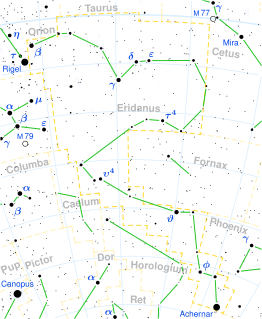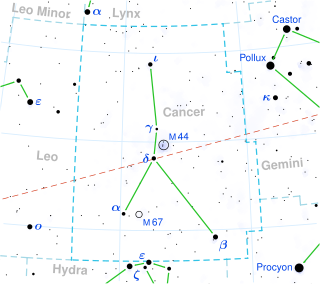
Alpha Cancri, also named Acubens, is a star system in the constellation of Cancer.

Beta Cancri, also named Tarf, is the brightest star in the zodiacal constellation of Cancer. It has an apparent visual magnitude of +3.5 and an absolute magnitude of −1.2. Based on parallax measurements obtained during the Hipparcos mission, it is approximately 290 light-years distant from the Sun. An exoplanet, designated Beta Cancri b, is believed to be orbiting the star.

Tau Eridani is a group of fairly widely scattered stars in the constellation Eridanus.
Eta Cancri, Latinized from η Cancri, is a single, orange-hued star in the zodiac constellation of Cancer. It is a faint star but visible to the naked eye with an apparent visual magnitude of 5.34. The annual parallax shift of 10.93 mas as seen from Earth yields a distance estimate of 155 light years from the Sun. It is moving further away with a radial velocity of +22 km/s.
Tau Cancri is a solitary, yellow-hued star in the zodiac constellation of Cancer. With an apparent visual magnitude of +5.42, it is faintly visible to the naked eye. Based upon an annual parallax shift of 11.92 mas as seen from Earth, it is located around 274 light years from the Sun.
Upsilon2 Cancri is a faint, yellow-hued star in the zodiac constellation of Cancer. It is near the lower brightness limit of stars that can be viewed with the naked eye, having an apparent visual magnitude of +6.35. Based upon an annual parallax shift of 5.87 mas as seen from Earth, this system is roughly 560 light years from the Sun.
Phi2 Cancri is a binary star in the constellation Cancer, about 280 light-years from Earth. Both components are white A-type main sequence dwarfs with apparent magnitudes of +6.3. They are separated by 5.126 arcseconds on the sky, and their mean apparent brightness is +5.55 magnitudes.
36 Cancri is a star in the southern part of the zodiac constellation of Cancer, located around 501 light years away from the Sun. It has the Bayer designation c Cancri; 36 Cancri is the Flamsteed designation. This object is a visible to the naked eye as a faint, white-hued star with an apparent visual magnitude of 5.92. It is moving further from the Earth with a heliocentric radial velocity of +16 km/s.
20 Cancri is an astrometric binary star system in the constellation Cancer, located about 348 light years away from the Sun. This system has the Bayer designation d1 Cancri; 20 Cancri is the Flamsteed designation. It is just visible to the naked eye under good viewing conditions, appearing as a dim, white-hued star with an apparent visual magnitude of 5.94. The pair are moving further from the Earth with a heliocentric radial velocity of +36 km/s, and are members of the Hyades Supercluster.
45 Cancri is a binary star system in the zodiac constellation of Cancer, located 680 light years away from the Sun. It has the Bayer designation A1 Cancri, (A1 Cnc); 45 Cancri is the Flamsteed designation. It is visible to the naked eye as a faint, white-hued star at an apparent visual magnitude of 5.62. The pair form a double-lined spectroscopic binary with an orbital period of 2.76 years and an eccentricity of 0.46.
ω2 Cancri is a star in the zodiac constellation Cancer, located around 810 light years away from the Sun. It has the Flamsteed designation 4 Cancri; ω2 Cancri is the Bayer designation, which is Latinised to omega2 Cancri and abbreviated to ω2 Cnc or omega2 Cnc. The star is near the lower limit of visibility to the naked eye, having an apparent visual magnitude of 6.32. It is moving closer to the Earth with a heliocentric radial velocity of −8 km/s. The position of this star near the ecliptic means it is subject to lunar occultations.
24 Cancri is a triple star system in the constellation Cancer. The system is located about 260 light-years away, based on its parallax. The system has a combined apparent magnitude of 6.91.
53 Cancri is a variable star in the zodiac constellation Cancer, located around 960 light years from the Sun. It has the variable star designation BO Cancri; 53 Cancri is the Flamsteed designation. This object is a challenge to view with the naked eye, having an apparent visual magnitude around 6. It is around 960 light years away.
57 Cancri is a double star in the zodiac constellation of Cancer, located around 460 light years away from the Sun. They are visible to the naked eye as a faint star with a combined apparent visual magnitude of +5.40. The brighter member, designated component A. is a yellow-hued giant star with a stellar classification of G7 III and an apparent magnitude of +6.09. Its companion, component B, is an orange-hued giant with a class of K0 III and an apparent magnitude of +6.37. As of 2017, the pair had an angular separation of 1.50″ along a position angle of 310°.
75 Cancri is a binary star in the constellation of Cancer. The system is located about 102 light-years away, based on its stellar properties.
83 Cancri is a star in the constellation Cancer. Its apparent magnitude is 6.61.
78 Cancri is a star in the zodiac constellation of Cancer, located 548 light years from the Sun. It is too faint to be viewed with the naked eye, having an apparent visual magnitude of 7.19. The star is moving away from the Earth with a relatively large radial velocity of +77.7 km/s. It is an evolved giant star with a stellar classification of K3 III.

X Cancri is a semiregular variable star located in the constellation Cancer. It varies between magnitudes 5.69 and 6.94 over 180 days. Located around 1116 light-years distant, it shines with a luminosity approximately 4695 times that of the Sun and has a surface temperature of 3317 K. It has a radius of 470 R☉.




